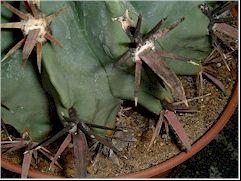
Sooty mould
on Ferocactus
Please go to our Glossary link at the bottom of the page for explanations of scientific terms
Identification
Desert cacti are frequently covered in ants. Cacti provide ants with nectar- a ready food supply in a harsh environment- in exchange for protection from herbivorous insects. Some cacti have extrafloral nectaries, these are located in the areoles at the base of the spines. Sugary nectar is secreted by these nectaries. If there are few ants present, this sugary secretion can become infected with a fungus, a sooty mould. This can detract from the appearance of the cactus. Whilst the mould can occur on several types of cacti, those most known for it are the Ferocacti.
An excellent article on extrafloral nectaries in cacti can be found here.
Prevention
Plants can be occasionally watered overhead, with a reasonably high pressure jet. This will help to remove the excess nectar. Keeping the air around the plants less humid will also help.In this case, actually encouraging the presence of ants around the plant would reduce the chance of getting sooty mould - but ants can bring other problems!

